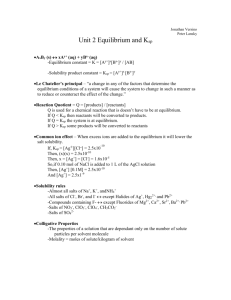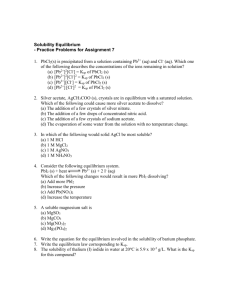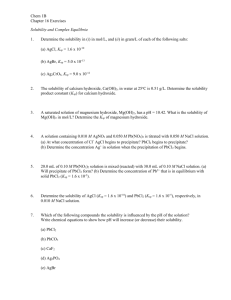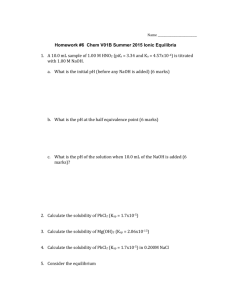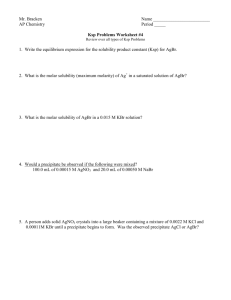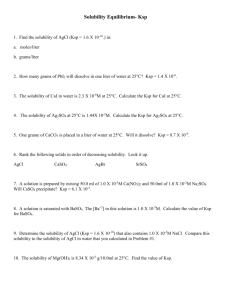Solutions: 2001 A
advertisement
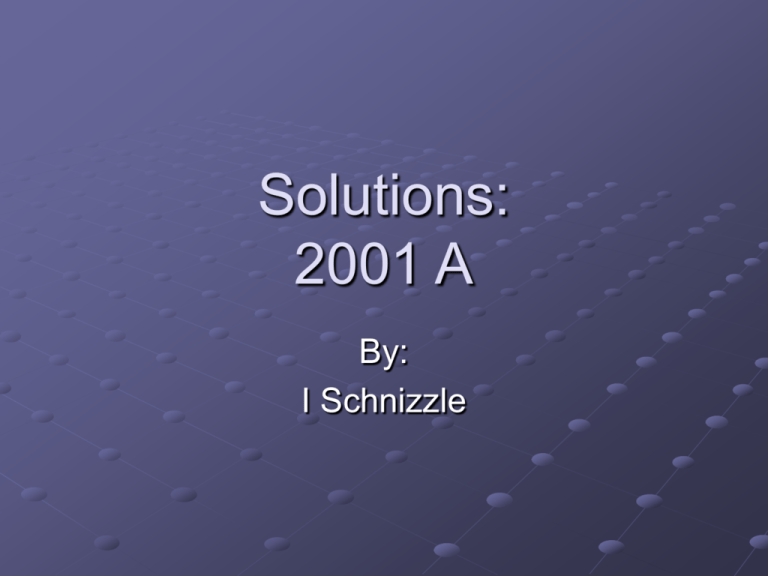
Solutions: 2001 A By: I Schnizzle 2001 A Part A (i) A.) At 10 degrees Celsius, 8.9 e-5 g. of AgCl(s) will dissolve in 100. mL of water. (i) Write the equation for the dissociation of AgCl(s) in water. Since AgCl is a solid the dissociation will be fairly simple. Basically just breaking the compound down into its ions. AgCl(s) yields Ag+(aq) + Cl-(aq) 2001 A Part A (ii) A.) At 10 degrees Celsius, 8.9 e-5 g. of AgCl(s) will dissolve in 100. mL of water. (ii) Calculate the solubility, in mol L-1, of AgCl(s) in water at 10 degrees Celsius. Convert the number of g. into moles and than divide by the number of liters and you will find the solubility. 2001 A Part A (ii) Cont’ 8.9e-5 x 1mol/ 143.32 (molar mass)= 6.20988e-7 Than take that number of moles and divide by .1 since you have 100 mL and need the number in liters. 6.20988e-7/.1= 6.20988e-6 mol/L 2001 A Part A (iii) A.) At 10 degrees Celsius, 8.9 e-5 g. of AgCl(s) will dissolve in 100. mL of water. (iii) Calculate the value of the solubility product constant, Ksp, for AgCl(s) at 10 degrees Celsius. Since the Ksp of AgCl is the products over the reactants and no pure solids or liquids are included the Ksp value is obtained simply by multiplication of the solubility of AgCl found in part ii. 2001 A Part A (iii) Cont’ Ksp= [Ag+][Cl-] Ksp=[6.20988e-6]^2=3.9e-11 You square the value since the solubility of the AgCl applies to both the Ag+ and Clions. And that gets you your Ksp. 2001 A Part B (i) B.) At 25 degrees Celsius the value of Ksp for PbCl2(s) is 1.6e-5 and the value for Ksp for AgCl(s) is 1.8e-10. (i) If 60.0 mL of 0.0400 M NaCl(aq) is added to 60.0 mL of 0.0300 M Pb(NO3)2(aq), will a precipitate form? Assume that volumes are additive. Show calculations to support your answer. To answer this question we need to compare the given Ksp to the one we find. 2001 A Part B (i) Cont’ First we need to find the molarity of the Pb+ and Cl60mL/(120mL) x .0400mol/1000mL=.0200 M[Cl-] 60mL/(120mL) x .0300mol/1000mL=.0150M[Pb2+] Than we use these molarities to find the trial Ksp. [Pb2+][Cl-]=(.0150)^2(.0200)=6.0e-6 Since the trial Ksp is less than the actual Ksp a precipitate will not form. 6.0e-6 is less than 1.6e-5 2001 A Part B (ii) B.) At 25 degrees Celsius the value of Ksp for PbCl2(s) is 1.6e-5 and the value for Ksp for AgCl(s) is 1.8e-10. (ii) Calculate the equilibrium value of [Pb2+(aq)] in 1.00 L of saturate PbCl2 solution to which 0.250 mole of NaCl(s) has been added. Assume that no volume change occurs. To solve this problem all that is required is some manipulation of the information you already have. 2001 A Part B (ii) Cont’ Since the Ksp is equal to [Pb2+][Cl-]^2 the only step is to divde the Ksp by the [Cl-]^2 concentration and you have your Ksp for [Pb2+]. [Pb2+]=Ksp/[Cl-]^2 [Pb2+]=1.6e-5/(.250M)^2 Since the .250 mol is in 1L it can be used as the molarity [Pb2+]= 2.6e-4 M 2001 A Part B (iii) B.) At 25 degrees Celsius the value of Ksp for PbCl2(s) is 1.6e-5 and the value for Ksp for AgCl(s) is 1.8e-10. (iii) If 0.100 M NaCl(aq) is added slowly to a beaker containing both 0.120 M AgNO3(aq) and 0.150 M Pb(NO3)2(aq) at 25 degrees Celsius, which will precipitate first, AgCl(s) or PbCl2(s)? Show calculations to support your answer. The first thing that is necessary to complete this question is to find the concentrations of Cl- in each of the PbCl2 and AgCl compounds. 2001 A Part B (iii) Cont’ For AgCl the Cl- concentration is Ksp/[Ag+] so 1.8e-10/.120= 1.5e-9M You get the .120 concentration of Ag+ from the amount in the beaker from AgNO3(aq) since it dissociates completely. Next is the PbCl2, the concentration is the sqrt. of the Ksp/[Pb2+] since there are two Cl’s for every one Pb2+ that’s why it is sqrt. So it is sqrt. of 1.6e-5/.150=.0103M The .150 is the concentration of Pb2+ from the Pb(NO3)2 since the NO3 dissociates completely like in AgNO3. 2001 A Part B (iii) Cont’ Since the concentration of the AgCl needed to form a precipitate is so much less than that of the PbCl2 it will form the precipitate before the PbCl2 does. Gangluff rocks that CS Baby!!! Shout out to my CS boys Danny, Andy, Mikey, and Bhavih… Hi to you to Dave.
